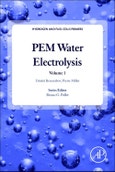Hydrogen Energy and Fuel Cell Primers is a series of concise books that present those coming into this broad and multidisciplinary field the most recent advances in each of its particular topics. Its volumes bring together information that has thus far been scattered in many different sources under one single title, which makes them a useful reference for industry professionals, researchers and graduate students, especially those starting in a new topic of research.
These volumes, PEM Water Electrolysis vol 1 and 2, allows these readers to identify the technology gaps for the development of commercially viable PEM electrolysis systems for energy applications. This primer examines the fundamentals of PEM electrolysis and selected research topics that are currently subject of attention by academic and industry community, such as gas cross-over and AST protocols. This lays the foundation for the exploration of the current industrial trends for PEM electrolysis, such as power to gas application, are discussed, with strong focus on the current trends in the application of PEM electrolysis associated with energy storage. These include durability aspects of PEM electrolysis systems and components, accelerated stress test protocols, manufacturing aspects of large-scale electrolyzers and components, gas crossover problems in PEM electrolyzer safety, and challenges associated with high-current density operation of PEM electrolyzers. A technology development matrix for systems and components requirements will also be covered, as well as unconventional PEM water electrolysis systems, such as ozone generators
Please Note: This is an On Demand product, delivery may take up to 11 working days after payment has been received.
Table of Contents
1. Introduction 2. Brief Historical Background of Water Electrolysis 3. Fundamentals of Water Electrolysis 4. The Individual Proton-Exchange Membrane Cell and Proton-Exchange Membrane Stack 5. Gas Permeation in PEM Water Electrolyzers
Authors
Dmitri Bessarabov Director, DST National Center of Competence, HySA Infrastructure, North-West University and CSIR, South Africa. Dr. Dmitri Bessarabov joined DST HySA Infrastructure Center of Competence at North-West University and CSIR in 2010. He was recruited for a position from Canada as an internationally-recognised scientist with academic and industrial decision-making experience in the area of membranes, hydrogen and electro-catalytic membrane systems for energy applications and fuel cells. He obtained his PhD from Stellenbosch University in membrane technology for gas separation. Dr Dmitri Bessarabov held positions in Aker Kvaerner Chemetics, Ballard Power Systems and the Automotive Fuel Cell Cooperation (AFCC). Dmitri is also National Research Foundation-rated scientist in South Africa. His expertise includes membranes, MEAs and CCMs. He was leading CCM and MEA integration research team at AFCC for HyWAY 5 automotive program. His current responsibilities at HySA include leadership in the National Hydrogen and Fuel Cell Programme (HySA), providing excellence in management, research and product development, HySA Infrastructure Business Plan development and implementation, supply-chain and business development, engagement of industry into development activities. Pierre Millet Professor, Department of Chemistry, Institute of Molecular Chemistry and Material Science, Paris-Sud University, Orsay, France. 1986 : Diploma of electrochemical engineering at "Ecole Nationale Supérieure d'Electrochimie et d'Electrométallurgie", Grenoble, France1989 : PhD in electrochemistry from "Institut National Polytechnique de Grenoble, France; Laboratory : Commissariat à l'Energie Atomique, Centre d'Etudes Nucléaires de Grenoble, France. PhD title : Preparation and optimisation of membrane-electrode assemblies. Application to water electrolysis.








